Minho Shim
Classification Matters: Improving Video Action Detection with Class-Specific Attention
Jul 29, 2024Abstract:Video action detection (VAD) aims to detect actors and classify their actions in a video. We figure that VAD suffers more from classification rather than localization of actors. Hence, we analyze how prevailing methods form features for classification and find that they prioritize actor regions, yet often overlooking the essential contextual information necessary for accurate classification. Accordingly, we propose to reduce the bias toward actor and encourage paying attention to the context that is relevant to each action class. By assigning a class-dedicated query to each action class, our model can dynamically determine where to focus for effective classification. The proposed model demonstrates superior performance on three challenging benchmarks with significantly fewer parameters and less computation.
Masked Autoencoder for Unsupervised Video Summarization
Jun 02, 2023



Abstract:Summarizing a video requires a diverse understanding of the video, ranging from recognizing scenes to evaluating how much each frame is essential enough to be selected as a summary. Self-supervised learning (SSL) is acknowledged for its robustness and flexibility to multiple downstream tasks, but the video SSL has not shown its value for dense understanding tasks like video summarization. We claim an unsupervised autoencoder with sufficient self-supervised learning does not need any extra downstream architecture design or fine-tuning weights to be utilized as a video summarization model. The proposed method to evaluate the importance score of each frame takes advantage of the reconstruction score of the autoencoder's decoder. We evaluate the method in major unsupervised video summarization benchmarks to show its effectiveness under various experimental settings.
Decomposed Cross-modal Distillation for RGB-based Temporal Action Detection
Mar 30, 2023Abstract:Temporal action detection aims to predict the time intervals and the classes of action instances in the video. Despite the promising performance, existing two-stream models exhibit slow inference speed due to their reliance on computationally expensive optical flow. In this paper, we introduce a decomposed cross-modal distillation framework to build a strong RGB-based detector by transferring knowledge of the motion modality. Specifically, instead of direct distillation, we propose to separately learn RGB and motion representations, which are in turn combined to perform action localization. The dual-branch design and the asymmetric training objectives enable effective motion knowledge transfer while preserving RGB information intact. In addition, we introduce a local attentive fusion to better exploit the multimodal complementarity. It is designed to preserve the local discriminability of the features that is important for action localization. Extensive experiments on the benchmarks verify the effectiveness of the proposed method in enhancing RGB-based action detectors. Notably, our framework is agnostic to backbones and detection heads, bringing consistent gains across different model combinations.
Exploring Temporally Dynamic Data Augmentation for Video Recognition
Jun 30, 2022
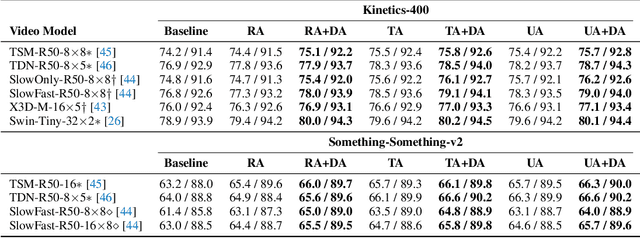
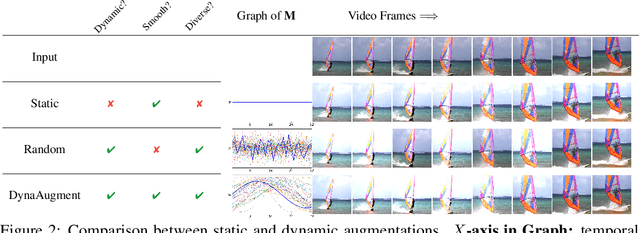

Abstract:Data augmentation has recently emerged as an essential component of modern training recipes for visual recognition tasks. However, data augmentation for video recognition has been rarely explored despite its effectiveness. Few existing augmentation recipes for video recognition naively extend the image augmentation methods by applying the same operations to the whole video frames. Our main idea is that the magnitude of augmentation operations for each frame needs to be changed over time to capture the real-world video's temporal variations. These variations should be generated as diverse as possible using fewer additional hyper-parameters during training. Through this motivation, we propose a simple yet effective video data augmentation framework, DynaAugment. The magnitude of augmentation operations on each frame is changed by an effective mechanism, Fourier Sampling that parameterizes diverse, smooth, and realistic temporal variations. DynaAugment also includes an extended search space suitable for video for automatic data augmentation methods. DynaAugment experimentally demonstrates that there are additional performance rooms to be improved from static augmentations on diverse video models. Specifically, we show the effectiveness of DynaAugment on various video datasets and tasks: large-scale video recognition (Kinetics-400 and Something-Something-v2), small-scale video recognition (UCF- 101 and HMDB-51), fine-grained video recognition (Diving-48 and FineGym), video action segmentation on Breakfast, video action localization on THUMOS'14, and video object detection on MOT17Det. DynaAugment also enables video models to learn more generalized representation to improve the model robustness on the corrupted videos.
Spatiotemporal Augmentation on Selective Frequencies for Video Representation Learning
Apr 08, 2022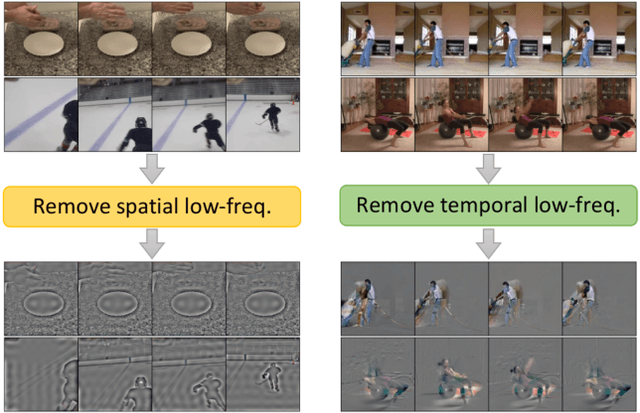
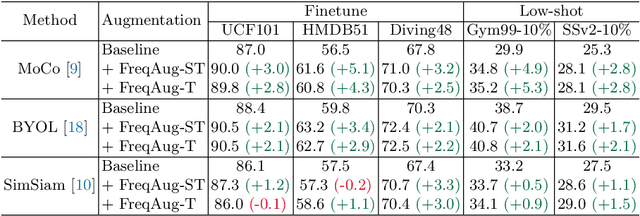
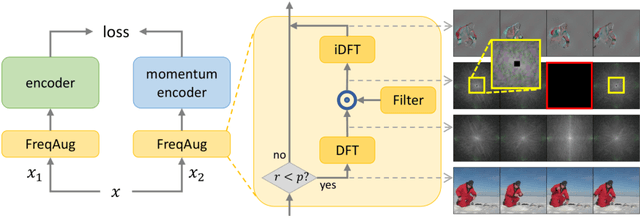
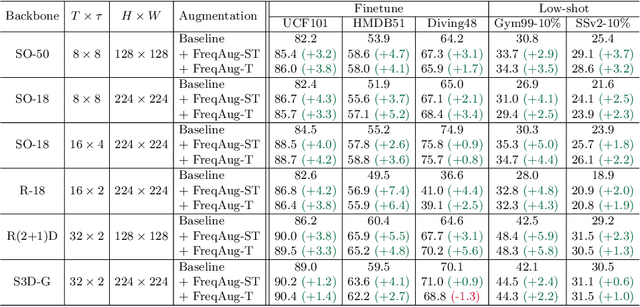
Abstract:Recent self-supervised video representation learning methods focus on maximizing the similarity between multiple augmented views from the same video and largely rely on the quality of generated views. In this paper, we propose frequency augmentation (FreqAug), a spatio-temporal data augmentation method in the frequency domain for video representation learning. FreqAug stochastically removes undesirable information from the video by filtering out specific frequency components so that learned representation captures essential features of the video for various downstream tasks. Specifically, FreqAug pushes the model to focus more on dynamic features rather than static features in the video via dropping spatial or temporal low-frequency components. In other words, learning invariance between remaining frequency components results in high-frequency enhanced representation with less static bias. To verify the generality of the proposed method, we experiment with FreqAug on multiple self-supervised learning frameworks along with standard augmentations. Transferring the improved representation to five video action recognition and two temporal action localization downstream tasks shows consistent improvements over baselines.
 Add to Chrome
Add to Chrome Add to Firefox
Add to Firefox Add to Edge
Add to Edge